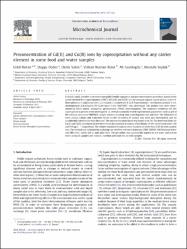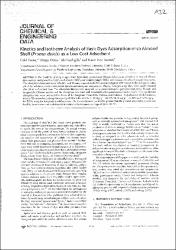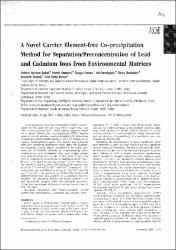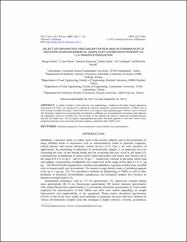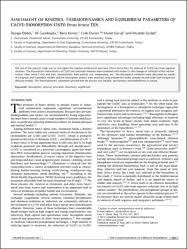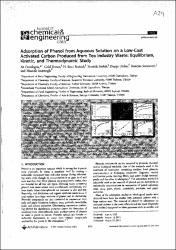Ara
Toplam kayıt 10, listelenen: 1-10
Preconcentration of Cd(II) and Cu(II) ions by coprecipitation without any carrier element in some food and water samples
(Elsevier Science Bv, 2011)
A simple, rapid, sensitive and environmentally friendly separation and preconcentration procedure, based on the carrier element free coprecipitation (CEFC) of Cu(II) and Cd(II) ions by using an organic coprecipitant, ...
Kinetics and Isotherm Analysis of Basic Dyes Adsorption onto Almond Shell (Prunus dulcis) as a Low Cost Adsorbent
(Amer Chemical Soc, 2011)
The feasibility of using an agricultural byproduct, almond shell (Prunus dulcis), as an adsorbent in removal of basic dyes, namely, methylene blue (MB), methyl violet (MV), and toluidine blue 0 (TB), were evaluated in a ...
Adsorption of Cu(II) ions from aqueous solution by hazelnut husk activated carbon prepared with potassium acetate
(Taylor & Francis Inc, 2018)
Hazelnut husk (HH), an agricultural waste, was converted to carbonaceous material by chemical activation using potassium acetate. The produced activated carbon (KAHHAC) was characterized by FTIR, SEM, N-2 adsorption-desorption ...
Physicochemical characteristics of a novel activated carbon produced from tea industry waste
(Elsevier Science Bv, 2013)
Tonnes of waste are generated during tea production in Turkey, one of the black tea producing countries in the world. These wastes are not used for any purposes throughout industrial sector. The objective of this study is ...
Dehydrated hazelnut husk carbon: a novel sorbent for removal of Ni(II) ions from aqueous solution
(Desalination Publ, 2012)
The present study has been performed to examine the adsorption ability of novel sorbent dehydrated hazelnut husk carbon (DHHC) towards Ni(II) ions from aqueous solution using the batch adsorption technique. The effective ...
A Novel Carrier Element-free Co-precipitation Method for Separation/Preconcentration of Lead and Cadmium Ions from Environmental Matrices
(Wiley, 2016)
A new separation and pre-concentration method was presented in this study for two trace heavy metal ions, lead (Pb2+) and cadmium (Cd2+) from aqueous solutions, based on a carrier element free co-precipitation (CEFC) method ...
SELECTIVE SEPARATION, PRECONCENTRATION AND DETERMINATION OF Pd(II) IONS IN ENVIRONMENTAL SAMPLES BY COPRECIPITATION WITH A 1,2,4-TRIAZOLE DERIVATIVE
(Chem Soc Ethiopia, 2015)
A simple, sensitive, facile and low cost methodology, combined with flame atomic absorption spectrometry (FAAS), was employed to evaluate the selective separation and preconcentration of Pd(II) ions in environmental samples ...
ASSESSMENT OF KINETICS, THERMODYNAMICS AND EQUILIBRIUM PARAMETERS OF CR(VI) BIOSORPTION ONTO Pinus brutia TEN
(Wiley, 2014)
The aim of the present study was to investigate the sorption potential of pine bark (Pinus brutia Ten.) for removal of Cr(VI) ions from aqueous solutions. The biosorption characteristics of Cr(VI) ions onto bark biomass ...
Adsorption of Phenol from Aqueous Solution on a Low-Cost Activated Carbon Produced from Tea Industry Waste: Equilibrium, Kinetic, and Thermodynamic Study
(Amer Chemical Soc, 2012)
The ability of activated carbon which was produced by chemical activation using zinc chloride from tea industry wastes (TIWAC) to adsorb phenol molecules from aqueous solution was tested by equilibrium, kinetic, and ...
Separation and pre-concentration of palladium(II) from environmental and industrial samples by formation of a derivative of 1,2,4-triazole complex on Amberlite XAD-2010 resin
(Taylor & Francis Ltd, 2013)
A simple separation/pre-concentration method was developed for extraction of Pd(II) in various environmental samples, based on its adsorption of 4-phenyl-5-{[(4-phenyl-5-pyridin-4-yl-4H-1,2,4-triazole-3-yl)thio]methyl}-4 ...

